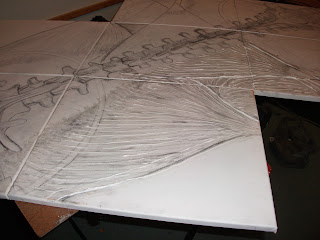My biggest challenge is the set of issues occurring in my back. I have had two surgeries (four level cervical fusion and a lumbar laminectomy/discectomy,) as well as dozens of epidural injections, trigger point injections, radio frequency thermo-coagulation and other similar procedures. I've got an erector set's worth of titanium in the neck. This all results from degenerative discs and a lot of spinal stenosis. Other goodies like bone spurs and facet issues round out the fun.
Besides the surgeries, I take a lot of pain meds and do physical therapy. I've done a lot of acupuncture as well. I don't really want to detail the ways that all this impacts my life, just take it for granted that this is my biggest thing to paint about.
So I wanted to make a big canvas. I considered some very large canvases I had stretched for video screens, but they weren't really taught enough to make me happy. I considered large wood panels, but with the necessary cradling, they would get really heavy. I also wanted to use the size and structure of the framing to say something about the my personal spinal framing issues.
For the composition, I knew I wanted the back, the spine and the cervical and lumbar vertebrae to figure prominently. I love anatomy art, and easily found great imagery, primarily from Gray's Anatomy.
I worked these images on the computer to arrive at a first pass composition:
Now I had to pick the surface to paint on. I realized that I had a lot of blank, prepped 16"x20" canvases. I'd already noticed that when you hang a rectangular panel by one corner, the plumb line that results is not the same as the diagonal between corners. It is for a square, but for a rectangle, it isn't. I wondered if that would hold true if I used an arrangement of joined panels. Eventually, I constructed a model in cardstock to test this idea:
This got me excited! The combination of the 16"x20" panels would be both large and non-standard. It wouldn't be just another rectangle. Also, the visual dissonance set up between the plumb line and the diagonal line would be a great underlying comment on the issues I face with my spine.
I worked the computer composition onto the new layout:
Joining the panels was pretty easy. I used deck plates and simply screwed all panels to their neighbors. This results in a very strong and light structure at a fraction of the cost of a comparable sized single canvas!
I began sketching the image:
I wanted something with a lot of texture. I'd recently become interested in Modeling Paste, an acrylic binder with marble dust. This can be added to thicken paint. But I wanted to underpaint the canvas with a texture layer. I used the modeling paste two ways, as finger paint for the muscle striations, and then using a cake decorating set for the actual vertebral outlines. This resulted in a wonderful surface to start putting color on!
The resulting picture is 75"x50"
Here's a picture of it hanging at Art Outside Austin in 2010 for a sense of scale:
Cheers,
--Tim
















Well, this is interesting. I know a lot of about posture corrector from this post. Thank you very much.
ReplyDeleteposture support brace woman